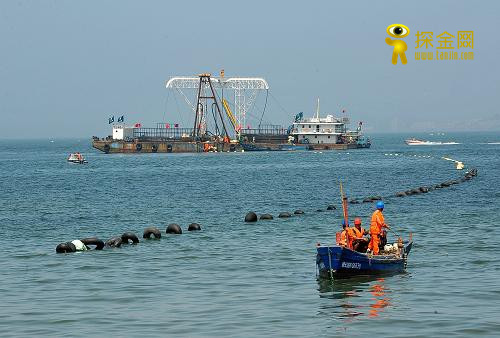
At 9:20 on June 8th, in the planning of the Zhejiang East Pole Project submarine cable route, the "Zhoudian 10" ship was driving on the sea, and a multi- beam echo sounder was connected to a steel pipe on the ship's side. To the sea. At the same time, on the computer in the cabin, the high-precision topography of the seabed is presented in front of everyone in the form of 3D images. This is the first set of commissioning survey scenarios conducted by the first “submarine cable integrated detection system †in China.
It is understood that this system includes a total of six advanced instruments, and is the first comprehensive detection system for submarine cable construction and operation and maintenance in China.
The multi-beam echo sounder and Doppler velocity profiler were tested on the same day. The multi-beam echo sounder uses ultrasonic waves to detect the deepest 500 meters deep seabed with a horizontal detection range of 1,200 meters. The topography of the seabed it detects can be reproduced on a computer in 3D. The Doppler velocity profiler also uses ultrasonic waves to divide 300 meters deep seawater into 172 layers and measure the flow and direction of seawater at different levels. “With these two detection instruments , the laying attitude, operating conditions, and the topography of the seabed can be clearly seen in the future.†Yu Enke, deputy chief engineer of Zhoushan Power Supply Company, said that the system will help improve the accuracy and operation of the laying of submarine cables. reliability.
In addition to the two instruments, the submarine cable integrated detection system also includes four instruments such as a submarine cable tracker, a submarine static penetrator, a temperature probe, a seabed column, and a box sampler. "The instruments we use are at the top international level," said Yuen Ke. It is understood that this system has a total investment of nearly 10 million yuan. After many sea trials, it will be applied to the investigation, design, construction, and transportation inspection of submarine cables in Zhoushan. Yu Enke said that after the system is put into operation, it will enable China's submarine cable design, construction, and transportation inspection technologies to reach a higher level.
Little friends, rushing to pay attention to the gold bar Internet cafes, take you to explore the latest and most complete information in the industry, let us explore further!
  Â
"Gravity Die Casting. A permanent mould casting process, where the molten metal is poured from a vessle of ladle into the mould, and cavity fills with no force other than gravity, in a similar manner to the production of sand castings, although filling cn be controlled by tilting the die."
Gravity Die Casting
Sometimes referred to as Permanent Mould, GDC is a repeatable casting process used for non-ferrous alloy parts, typically aluminium, Zinc and Copper Base alloys.
The process differs from HPDC in that Gravity- rather than high pressure- is used to fill the mould with the liquid alloy.
GDC is suited to medium to high volumes products and typically parts are of a heavier sections than HPDC, but thinner sections than sand casting.
There are three key stages in the process.
- The heated mould [Die or Tool] is coated with a die release agent. The release agent spray also has a secondary function in that it aids cooling of the mould face after the previous part has been removed from the die.
- Molten metal is poured into channels in the tool to allow the material to fill all the extremities of the mould cavity. The metal is either hand poured using steel ladles or dosed using mechanical methods. Typically, there is a mould [down sprue" that allows the alloy to enter the mould cavity from the lower part of the die, reducing the formation of turbulence and subsequent porosity and inclusions in the finished part.
- Once the part has cooled sufficiently, the die is opened, either manually or utilising mechanical methods.
Advantages
- Good dimensional accuracy
- Smoother cast surface finish than sand casting
- Improved mechanical properties compared to sand casting
- Thinner walls can be cast compared to sand casting
- Reverse draft internal pockets and forms can be cast in using preformed sand core inserts
- Steel pins and inserts can be cast in to the part
- Faster production times compared to other processes.
- Once the tolling is proven, the product quality is very repeatable.
- Outsourced Tooling setup costs can be lower than sand casting.
Gravity Casting Parts,Aluminum Alloy Gravity Casting Parts,Aluminum Gravity Die Casting Parts,Gravity Casting Aluminum Parts
HSI INDUSTRIEL LTD , https://www.hsiindustriel.com